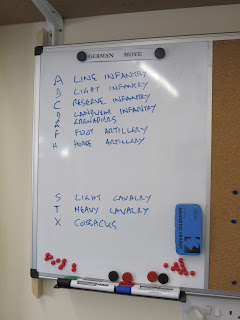I have mentioned before that I don't care for the way C&C handles victory conditions. And if one is going to move away from that part of the base design then why not move away from other elements? So, for the latest game to be set up in the annexe, I have changed the shape of the board. It is exactly the same area, but instead of 20 x 12 hexes it's 16 x 15.
The scenario is Maloyaroslavets (October 24th 1812) which involved the capture and recapture of a village (in the right centre of the board above). To eliminate wasted space on the flanks, try to make sure that cards applying to all sectors can be utilised and provide space for successive waves of attackers from either side it seemed appropriate to make it deeper and less wide.
I took the OOBs from here, but have played about with the terrain a bit. I have added an extra bridge to mitigate against a roadblock for the French and have only included slopes around the village itself, mainly for simplicity. One part of the village and both bridges are in hexes spanning two sectors. Rather than trying to identify arrival times - a concept that doesn't fit easily into C&C's turn structure - commands have been staggered back to the baseline. Each side has a couple of off table commands which can be brought on at any time. If we remember to use the March Move rule that we overlooked last time then it shouldn't be too difficult to get things into action. Victory conditions are the French have to hold the village and one bridge by the end of the evening in order to win. If they don't then the Russians win. The game starts with a weak French garrison in the village just about to be assaulted by a larger Russian force. What is obviously meant to happen is that they capture it only to be assaulted in turn and so on in turn. I envisage burst of fighting followed by periods of regrouping and manoeuvre into position. As usual, we shall see.
The river can be crossed by infantry and cavalry (stop on contact), but a dice is rolled. Sabres means the loss of a stand, flags means the unit stops in the hex before the river. If the river is entered as part of a mandatory retreat then for infantry and cavalry a dice is rolled and unit symbols and sabres count as hits, flags mean an extra hex of withdrawal; artillery are destroyed. The French on the southern side of the river have an extra option when withdrawing; they can either move one hex back towards the baseline as normal, or they can move one hex towards the nearest bridge.
We shall be using the EPIC rules with the shared open hand of cards. Hands will be six cards each (to try to make sure that one has options given that the action will concentrate in the centre) with, I think, a starting hand of four Tactician cards. We shall use our house rule regarding cards such as Bombard, which is basically that you can spread the effect across the whole table. There will be a pre-battle Mother Russia role (six dice), and I think I shall allow Cossacks and artillery to start the game with higher than normal strength if that's the way the dice come up. I have some Russian militia - with a rather nice holy banner - who have never seen any action so I am trying to work out how to tweak things to get a unit of those on table; if they don't appear during the retreat from Moscow then they never will.




No comments:
Post a Comment